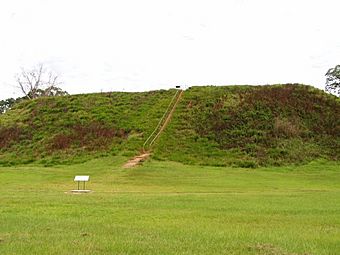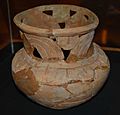Kolomoki Mounds facts for kids
|
Kolomoki Mounds
|
|

Temple Mound
|
|
| Nearest city | Blakely, Georgia |
|---|---|
| NRHP reference No. | 66000280 |
Quick facts for kids Significant dates |
|
| Added to NRHP | October 15, 1966 |
| Designated NHL | July 19, 1964 |
The Kolomoki Mounds are a really old and large group of earth mounds built by Native Americans. They are one of the biggest and earliest sites from the Woodland period in the southeastern United States, and the largest in Georgia. People built these mounds between 350 and 600 CE. You can find them in southwest Georgia, near the Chattahoochee River.
These mounds are so important that they were named a National Historic Landmark in 1964. Seven of the eight mounds are now protected as part of Kolomoki Mounds State Historic Park.
Contents
Exploring Kolomoki Mounds
Kolomoki Mounds State Park is a special place. It's an important archaeological site where scientists learn about the past. It's also a beautiful park for fun activities. Kolomoki covers about 300 acres, making it one of the biggest preserved mound sites in the USA.
Long ago, Kolomoki was a busy center for Native American life. It had villages, burial mounds, and a special open area called a ceremonial plaza. The eight visible earth mounds in the park were built by people from the Swift Creek and Weeden Island cultures between 250 and 950 CE. These mounds include Georgia's oldest great temple mound, which has a flat top. There are also two burial mounds and four smaller ceremonial mounds.
The people who built these mounds were very clever. They lined up some of the mounds with important events in the sky. For example, Mounds A, D, and E point to where the sun rises during the spring equinox. Mounds F and D line up with the sun during the summer solstice.
Amazing Mounds at Kolomoki
The Tall Temple Mound
The Temple Mound is about 56 feet (17 meters) tall. Its base is 325 feet (99 meters) long and 200 feet (61 meters) wide. Imagine how much work that was! Experts believe it took over two million basket loads of earth, carried by many people, to build this huge mound. The southern part of the mound is a bit higher and was probably a platform for a temple. From the top, you can see most of the Kolomoki area.
About 1,500 to 2,000 people lived in a village of thatched houses around a large open plaza. This plaza was a place for public ceremonies, rituals, and even games.
Mound D: A Burial Place
Mound D is one of the eight mounds you can see at Kolomoki. It's a round mound, about 20 feet (6 meters) high. It's right in the middle of the Kolomoki site. Archaeologists found the remains of 77 burials here, along with special ceremonial pottery. Some of this pottery was shaped like animals and birds, such as deer, quail, and owls. These are called effigy pots.
Mound D was built in several steps. It started as a square platform mound, about 6 feet (1.8 meters) tall, made of yellow clay. Sixty pottery vessels, including the animal-shaped ones, were placed on its east side.
Over time, more burials were added, and more yellow clay was used to make the mound bigger and rounder, about 10 feet (3 meters) tall. These burials were on the eastern side, and the skulls faced east, towards the rising sun. This was likely for religious reasons. People also included special items with the burials, like objects made from iron and copper, and pearl beads. Finally, the entire mound was covered with red clay.
The Kolomoki Museum
The park's museum is very unique because it was built around part of an actual excavated mound. This means you can see the archaeological dig inside the museum! The museum shows a film about how this mound was built and how archaeologists uncovered its secrets.
In the past, some valuable ancient pots and other items went missing from the museum. Many of these pieces were later found by police and dealers in Florida. However, more than 70 relics are still missing. The Georgia Department of Natural Resources (DNR) is asking for the public's help to find these important artifacts. Experts believe the pots might be in Georgia or Florida, perhaps with collectors.
Park Manager Matt Bruner said that these items are a key part of North American history. He explained that they should be protected for future generations to study. He also mentioned their deep meaning to Native American people, as many were used in burial ceremonies. These pots also show the amazing skill of the Kolomoki culture. The state is more interested in getting the pots back than in punishing those who have them.
Gallery
See also








